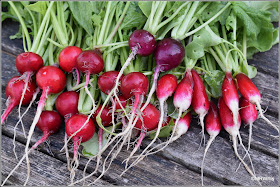We have been eating a fair bit of Baby Leaf Salad and Rocket, but the high spot of this week has been the harvest of my first big batch of Radishes. We had had a few prior to this, but just half a dozen at a time. Here we have 2 x "Cherry Belle", 3 x "Malaga Purple", 2 x "White Icicle" (aka "Eiszapfen" from Lidl!)and 3 x "French Breakfast".
This is different though...
There are four different varieties of Radish in these photos. The round red ones are "Scarlet Globe" and "Cherry Belle", the long red-and-white ones are "French Breakfast", and on the top of the pile are just two "Malaga Purple".
To produce good Radishes I think there are probably three golden rules:
1. Choose a site that will get lots of sunlight
2. Sow the seed thinly - about an inch between seeds.
3. Water frequently, regularly and copiously
Radishes grown in dry soil almost always bolt before plumping-up, but even if they do, all is not lost. You can let them flower and produce seeds for sowing next year - and the seed-pods are edible too!
When it comes to eating Radishes, yes we do sometimes have them sliced as a salad ingredient, but our favourite way to eat them is dipped in salt, as an accompaniment to a pre-dinner drink.
If I had heaps of Radishes I might be tempted to cook some, because I've heard that they are nice stir-fried, or even roasted. Likewise, you can eat the leaves (lightly steamed, to accompany Chinese food is a good way, apparently). All this is hypothetical though, because I never have large quantities of Radishes and I don't want to risk being without our favourite snack!





What a great blog, Mark! I am just setting up my vegetable patch in Stockholm, Sweden - I am from Australia originally. I note that your vegetable pallets are generally only one pallet high (not stacked on top of each other) - is this a good height to grow tomato’s, cucumbers, squash etc or is it better to stack two on top of each other? In Sweden it seems to be common to have them higher (two pallets high).
ReplyDeleteI'm sorry, but I don't understand this. What do you mean by "pallet"?
DeleteThis comment has been removed by the author.
DeleteThis comment has been removed by the author.
DeleteI would call that a radish bounty, Mark. How many would you need to consider it heaps?
ReplyDeleteMy needs are modest, Sue! I reckon about twice as many as seen here would count as "heaps" :)
DeleteMark, I think Kirstie may be asking about how deep to have the beds ie the number of sleepers/planks.
ReplyDeleteAh, OK, that makes sense! Thanks for clarifying. However, as all my recent posts demonstrate, the raised beds I have now (built several years ago) are double-height ones - two 20cm-high "sleepers", one on top of the other. In the old days I used to have much shallower beds, but I realised that deeper ones would be better, so I gradually replace them.
DeleteNice looking radish Mark.I've been pulling my first batch that have spent nearly all of their time under Thermacrop mesh.White Icicle was a new one for me this year but has growth well and with a crisp delicate flavour.Also good results with my standby Long Scarlet which has an unprepossessing top section disguising a long tap root.A couple more small successions also on the go and then I'll wait until mid July to try growing Red Flesh a winter variety.
ReplyDelete